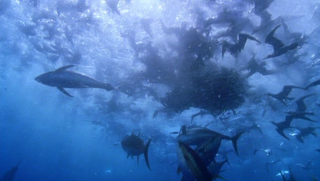Sounds Of Nature: Part II
THE SOUNDS OF NATURE, PART II:
Sound Editing in Nature Docs: The Second Narrator
by
Neal Romanek
(as printed in the October 2007
Sound Editing in Nature Docs: The Second Narrator
by
Neal Romanek
(as printed in the October 2007
edition of TVBEurope)
If the nature documentary is one of the most important genres in British broadcasting, could Kate Hopkins and her colleague, Tim Owens, be among British broadcasting's most important figures?
Hopkins and Owens have been sound designers on many groundbreaking wildlife documentaries, including the recent "Planet Earth" (2006), the BAFTA-winning "Blue Planet" (2001), and Sir David Attenborough's "The Life Of Mammals" (2002). Should anyone dare suggest that documentary is a less "creative" genre than narrative programming, a conversation with Kate Hopkins will set them straight.
 Kate Hopkins and Tim Owens work out of their Bristol-based company, Wounded Buffalo. It takes them roughly three weeks to cut a 50-minute segment. Cutting sound on 50 minutes of "reality" TV would take a bare fraction of that time. In the case of the nature documentary, as much work – or more – must be done as on any narrative film of that length.
Kate Hopkins and Tim Owens work out of their Bristol-based company, Wounded Buffalo. It takes them roughly three weeks to cut a 50-minute segment. Cutting sound on 50 minutes of "reality" TV would take a bare fraction of that time. In the case of the nature documentary, as much work – or more – must be done as on any narrative film of that length.One of the great secrets of the nature doc, is that virtually all sound design is created in post. Sync sound, excepting commentary by Sir David Attenborough as he crouches next to a Bower Bird, is virtually never available. Wild tracks and atmospheres may be recorded at the location, but in most cases it falls to the sound editor to create the entire soundtrack from scratch.
The irony of designing sound for a high-quality nature documentary is that although the sound editor may be manufacturing the entire soundtrack herself, the final result must pass the kinds of rigorous tests of authenticity and accuracy that no other sound track must undergo. If a humpback whale song is cut into an underwater scene shot in Hawaiian waters, it must be the humpback's traditional Hawaiian Islands song, which is utterly distinct from the song the animal sings, say, off the coast of Alaska. Few would notice such a difference, or even care, but this is what distinguishes a film that entertains from one that educates, enlightens and captures the quintessence of life on earth.
The other invisible artists of the nature doc sound design are foley artists. All non-specific sound – rustles, footfalls on leaves, snow crunching under paws, crabs clattering over rocks – are done in foley sessions.
The stunning aerial shots of "Planet Earth" were shot using the Cineflex helicopter mount, which allowed stable close-ups to be shot from thousands of meters away. The real sound captured at the scene is merely the roar of the helicopter. But once the foley artists have had their crack at it, and those effects have been edited and mixed, an entire new level of information is brought to the fore. Even seemingly innocuous sound cues, a crunch here, a splash there, are profoundly powerful storytelling tools.
The core of the sound designers job is understanding the peculiar twist of the human brain when an action is accompanied by a simultaneous sound, the human brain makes the assumption that the action itself was the cause of the sound, and an action that creates a sound takes on greater importance than one that does not. Thus a simple bit of foley accentuating one movement or another, or subtly emphasizing the rustling of a stalking lion, literally leads our eye to very specific places on the screen at very specific moments. Watching the real scene unfold in nature, we would be very likely to miss little details of action, intent, cause, effect that are integral to the sound design. BBC nature docs have two narrators – Sir David Attenborough, and the sound effects themselves.
"Planet Earth" is a milestone in broadcasting, not only for being a start-to-finish HD production, but for its 5.1 surround sound. "We knew it was going to be that right from the beginning, which helps a lot. Within a 5.1 mix, you tend to hear more. You can spread things around much more. It's nice for atmospheres because you can have even more atmosphere in the surround, but still not lose the voice over in the middle. Most of the sound I've done has had the capability to be in 5.1. There were always enough layers there. But it's whether there's time in the mixing."
Bird songs represent a textbook instance where a lack of sync sound recorded while shooting presents a potential nightmare. A bird's song may be distinct not only to a particular species in a particular location, but to a particular bird performing one particular step in a mating ritual.
Hopkins notes, "The birds of paradise, for example, have calls which are very complicated. Even experts don't always know exactly which call is which. Sometimes if a producer likes something, sometimes the accuracy can drift a little bit because dramatically it works better." But more often than not, a researcher is called in with expertise in the appropriate area. "Tim did a scene with the capercaille, which is a bird notoriously difficult to lay sound for because it has such a complicated call. We had various people come in to check that it was right, and in the end it was absolutely fine. Bird calls are always the most difficult. One of the worst we had was trying to get a Mandarin duck calling her chicks. We put in the only recording that we had. It was the most awful recording. It was full of hiss, and at one point I thought, We just cannot put this in because it is so horrible. But it was accurate. And within the mix, between us and the mixer, we EQ'd it and put it through a lot of software. In the end it worked."
One of Hopkins most challenging shows - and perhaps most rewarding - was "Blue Planet".
Her ongoing collaboration with Tim Owens allows for a thematic unity throughout the series she works on. In the case of "Blue Planet" where whole sets of effects were being created, the clear and ongoing communication characteristic of their collaboration was essential to stay on course. To some degree, the creating of sound for "Blue Planet" was like building a sound track for a science fiction movie. Creating the effects in Earth's most unexplored regions yielded some daring choices.
 "Obviously, most of 'Blue Planet' is underwater. It could have been just music and a general underwater track. But we decided, between the producers and the sound editors, that we were going to go for something different, because no one knows what you could actually hear underwater. There are some very natural sounds that you hear – humpback whales and shrimp clicking. But I added some much bigger noises – the fish going past – because it just adds to the strength of the images. And then there were some very tiny creatures too that I added some very strange, very designed noises. Whether it was real or not, I'm not sure that that mattered. It worked with the picture."
"Obviously, most of 'Blue Planet' is underwater. It could have been just music and a general underwater track. But we decided, between the producers and the sound editors, that we were going to go for something different, because no one knows what you could actually hear underwater. There are some very natural sounds that you hear – humpback whales and shrimp clicking. But I added some much bigger noises – the fish going past – because it just adds to the strength of the images. And then there were some very tiny creatures too that I added some very strange, very designed noises. Whether it was real or not, I'm not sure that that mattered. It worked with the picture."Those who have seen "Blue Planet" will understand how much certain sequences hinge on their sound effects. The truly frightening scene of tuna tearing into a bait ball, for example, gains extraordinary impact from the "sound" made by the attacking tuna as they rocket past. We don't for a moment forget the tuna is one of the fastest fish in the sea.
"If you have a huge bait ball swirling round and round and round, you just feel like you need to hear something. And I think that is what sound editing is all about – adding strength to the images. And you don't always want to have music going through it. You need to hear what you think you might hear if you really there."
---
Labels: media production, nature documentaries



